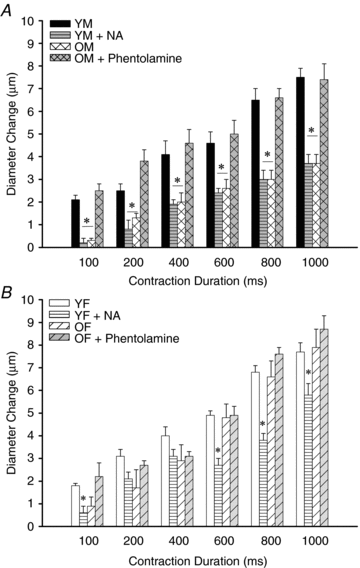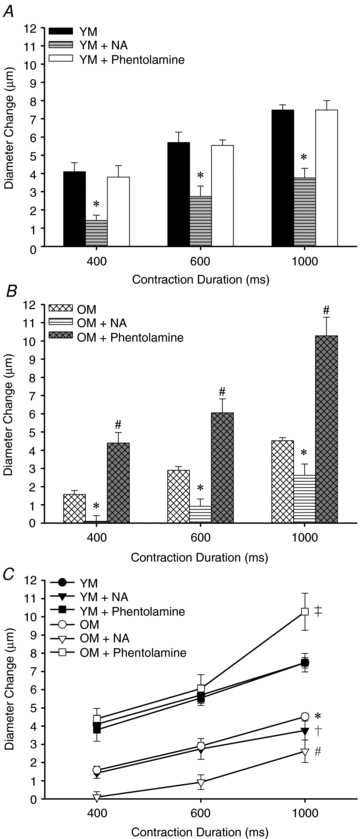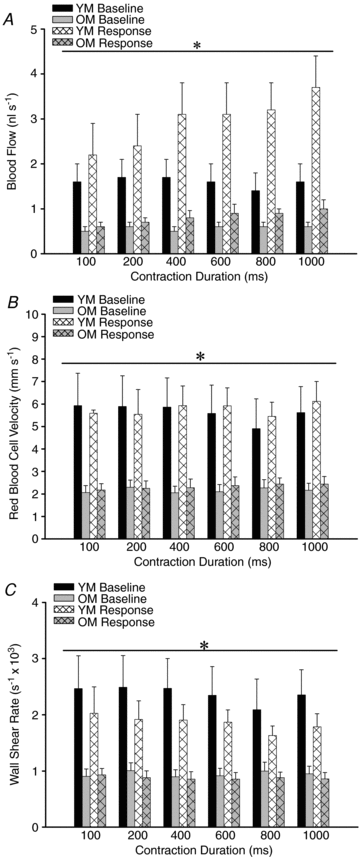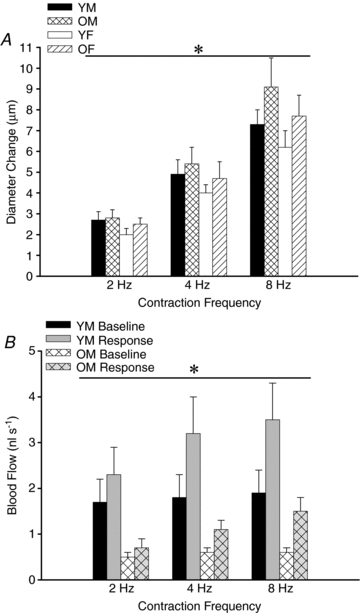Blunting of rapid onset vasodilatation and blood flow restriction in arterioles of exercising skeletal muscle with ageing in male mice
- PMID: 20375140
- PMCID: PMC2911225
- DOI: 10.1113/jphysiol.2010.189811
Blunting of rapid onset vasodilatation and blood flow restriction in arterioles of exercising skeletal muscle with ageing in male mice
Abstract
Exercise capacity and skeletal muscle blood flow are diminished with ageing but little is known of underlying changes in microvascular haemodynamics. Further, it is not clear how the sympathetic nervous system affects the microcirculation of skeletal muscle with ageing or whether sex differences prevail in the regulation of arteriolar diameter in response to muscle contractions. In the gluteus maximus muscle of C57BL/6 mice, we tested the hypothesis that ageing would impair 'rapid onset vasodilatation' (ROV) in distributing arterioles (second-order, 2A) of old (20-month) males (OM) and females (OF) relative to young (3-month) males (YM) and females (YF). Neither resting (approximately 17 microm) nor maximum (approximately 30 microm) 2A diameters differed between groups. In response to single tetanic contractions at 100 Hz (duration, 100-1000 ms), ROV responses were blunted by half in OM relative to OF, YM or YF. With no effect in YM, blockade of alpha-adrenoreceptors with phentolamine (1 mum) restored ROV in OM. Topical noradrenaline (1 nM) blunted ROV in YM and YF to levels seen in OM and further suppressed ROV in OM (P < 0.05). To evaluate arteriolar blood flow, red blood cell velocity was measured in 2A of OM and YM; respective heart rates (353 +/- 22 vs. 378 +/- 15 beats min(1)) and carotid arterial blood pressures (76 +/- 3 vs. 76 +/- 1 mmHg) were not different. Blood flows at rest (0.6 +/- 0.1 vs. 1.6 +/- 0.2 nl s(1)) and during maximum dilatation (2.0 +/- 0.8 vs. 5.4 +/- 0.8 nl s(1)) with sodium nitroprusside (10 microM) were attenuated >60% (P < 0.05) in OM. Blood flow at peak ROV was blunted by 75-80% in OM vs. YM (P < 0.05). In response to 30 s of rhythmic contractions at 2, 4 and 8 Hz, progressive dilatations did not differ with age or sex. Nevertheless, resting and peak blood flows in YM were 2- to 3-fold greater (P < 0.05) than OM. We suggest that ageing blunts ROV and restricts blood flow to skeletal muscle of OM through subtle activation of alpha-adrenoreceptors in microvascular resistance networks.
Figures






Comment in
-
Altered microvascular control of exercising skeletal muscle blood flow: the unfortunate male?J Physiol. 2010 Oct 15;588(Pt 20):3851-2. doi: 10.1113/jphysiol.2010.195800. J Physiol. 2010. PMID: 20952376 Free PMC article. No abstract available.
Similar articles
-
Differential α-adrenergic modulation of rapid onset vasodilatation along resistance networks of skeletal muscle in old versus young mice.J Physiol. 2016 Dec 1;594(23):6987-7004. doi: 10.1113/JP272409. Epub 2016 Sep 23. J Physiol. 2016. PMID: 27501249 Free PMC article.
-
Rapid versus slow ascending vasodilatation: intercellular conduction versus flow-mediated signalling with tetanic versus rhythmic muscle contractions.J Physiol. 2017 Dec 1;595(23):7149-7165. doi: 10.1113/JP275186. Epub 2017 Nov 9. J Physiol. 2017. PMID: 28981145 Free PMC article.
-
Contraction-evoked vasodilation and functional hyperaemia are compromised in branching skeletal muscle arterioles of young pre-diabetic mice.Acta Physiol (Oxf). 2014 Jun;211(2):371-84. doi: 10.1111/apha.12297. Acta Physiol (Oxf). 2014. PMID: 24703586
-
Microvascular mechanisms limiting skeletal muscle blood flow with advancing age.J Appl Physiol (1985). 2018 Dec 1;125(6):1851-1859. doi: 10.1152/japplphysiol.00113.2018. Epub 2018 Nov 9. J Appl Physiol (1985). 2018. PMID: 30412030 Free PMC article. Review.
-
Skeletal muscle vasodilatation during maximal exercise in health and disease.J Physiol. 2012 Dec 15;590(24):6285-96. doi: 10.1113/jphysiol.2012.241190. Epub 2012 Oct 1. J Physiol. 2012. PMID: 23027820 Free PMC article. Review.
Cited by
-
Depressed perivascular sensory innervation of mouse mesenteric arteries with advanced age.J Physiol. 2016 Apr 15;594(8):2323-38. doi: 10.1113/JP270710. Epub 2015 Jun 30. J Physiol. 2016. PMID: 26010764 Free PMC article.
-
Inhibitory effects of high extracellular L-glutamate concentrations on skeletal myogenesis.Sci Rep. 2025 May 19;15(1):17364. doi: 10.1038/s41598-025-01840-3. Sci Rep. 2025. PMID: 40389489 Free PMC article.
-
The effect of aging on the cutaneous microvasculature.Microvasc Res. 2015 Jul;100:25-31. doi: 10.1016/j.mvr.2015.04.004. Epub 2015 Apr 24. Microvasc Res. 2015. PMID: 25917013 Free PMC article. Review.
-
Altered microvascular control of exercising skeletal muscle blood flow: the unfortunate male?J Physiol. 2010 Oct 15;588(Pt 20):3851-2. doi: 10.1113/jphysiol.2010.195800. J Physiol. 2010. PMID: 20952376 Free PMC article. No abstract available.
-
Regional activation of rapid onset vasodilatation in mouse skeletal muscle: regulation through α-adrenoreceptors.J Physiol. 2010 Sep 1;588(Pt 17):3321-31. doi: 10.1113/jphysiol.2010.193672. Epub 2010 Jul 12. J Physiol. 2010. PMID: 20624796 Free PMC article.
References
-
- Anderson KM, Faber JE. Differential sensitivity of arteriolar α1- and α2-adrenoceptor constriction to metabolic inhibition during rat skeletal muscle contraction. Circ Res. 1991;69:174–184. - PubMed
-
- Armstrong ML, Dua AK, Murrant CL. Time course of vasodilation at the onset of repetitive skeletal muscle contractions. Am J Physiol Regul Integr Comp Physiol. 2007b;292:R505–515. - PubMed
-
- Bearden SE. Advancing age produces sex differences in vasomotor kinetics during and after skeletal muscle contraction. Am J Physiol Regul Integr Comp Physiol. 2007;293:R1274–1279. - PubMed
-
- Bearden SE, Linn E, Ashley BS, Looft-Wilson RC. Age-related changes in conducted vasodilation: effects of exercise training and role in functional hyperemia. Am J Physiol Regul Integr Comp Physiol. 2007;293:R1717–1721. - PubMed
Publication types
MeSH terms
Substances
Grants and funding
LinkOut - more resources
Full Text Sources
Medical
Research Materials
Miscellaneous

